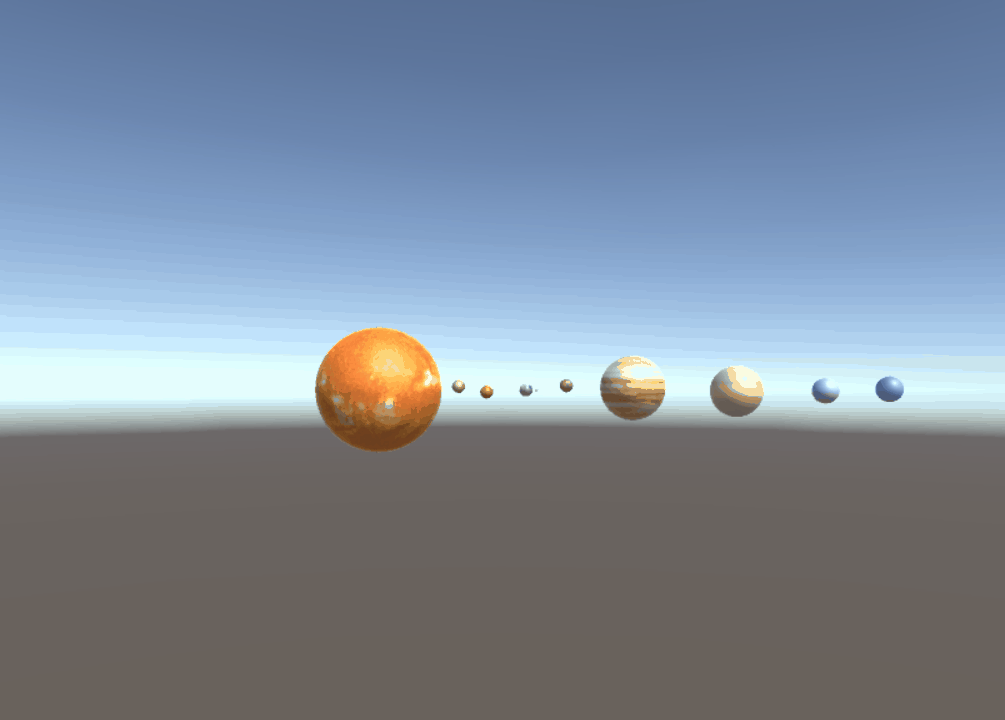游戏对象运动的本质是什么?
游戏对象的运动,是由游戏对象空间位置的连续变化所形成的。其中,游戏对象的空间位置由游戏中的坐标系统所决定,包含位置、旋转角度和缩放比例等属性。
请用三种方法以上方法,实现物体的抛物线运动。
抛体运动的特点
- 水平方向:匀速直线运动
- 竖直方向:自由落体运动(匀变速直线运动)
方法1:修改 transform 属性
1 | public float HorizontalSpeed = 1.0f; // 水平初速度 |
方法2:使用 transform.Translate 方法
1 | public float HorizontalSpeed = 1.0f; // 水平初速度 |
方法3:使用 Vector3.MoveTowards 方法
1 | public float HorizontalSpeed = 1.0f; // 水平初速度 |
方法4:添加 Rigidbody 组件
添加 Rigidbody 组件后,勾选 Use Gravity 属性,游戏对象便能受到重力作用。此时额外增加一个水平速度,即可实现游戏对象的平抛运动。
1
2
3
4
5
6public float speed = 1.0f;
void Update () {
// 水平方向匀速运动
this.transform.position += Vector3.left * speed * Time.deltaTime;
}
写一个程序,实现一个完整的太阳系, 其他星球围绕太阳的转速必须不一样,且不在一个法平面上。
游戏对象的层次结构

八大行星围绕太阳公转,因此应该设计为太阳的子对象。而月球的轨迹只与地球公转相关,与地球自转无关,因此不能将月球直接设为地球的子对象。解决办法是,新建一个空对象 EarthShadow,使它的位置与地球保持一致,再将月球设为 EarthShadow 的子对象,通过控制 EarthShadow 的自转速度来控制月球绕地球的公转速度。
游戏对象初始位置的确定
创建 RoundSun 脚本,新建不同游戏对象的 Transform 属性,并根据八大行星位置的相对关系,在 Start 函数中给 Transform 属性赋值。1
2
3
4
5
6
7
8
9
10
11
12
13
14
15
16
17
18
19
20
21
22
23
24
25
26
27public class RoundSun : MonoBehaviour {
// 创建太阳和各行星的位置属性
public Transform Mercury;
public Transform Venus;
public Transform Earth;
public Transform Mars;
public Transform Jupiter;
public Transform Saturn;
public Transform Uranus;
public Transform Neptune;
public Transform EarthShadow;
// Use this for initialization
void Start () {
// 初始化太阳和各行星的位置
Sun.position = Vector3.zero;
Mercury.position = new Vector3 (7, 0, 0);
Earth.position = new Vector3 (12, 0, 0);
Mars.position = new Vector3 (15, 0, 0);
Jupiter.position = new Vector3 (20, 0, 0);
Saturn.position = new Vector3 (28, 0, 0);
Uranus.position = new Vector3 (35, 0, 0);
Neptune.position = new Vector3 (40, 0, 0);
EarthShadow.position = new Vector3 (12, 0, 0);
}
}
公转和自转
接下来,在 Update 函数中用 RotateAround 方法实现行星的公转,用 Rotate 实现行星的自转。根据太阳系相关数据设定参数。1
2
3
4
5
6
7
8
9
10
11
12
13
14
15
16
17
18
19
20
21
22
23
24
25
26public class RoundSun : MonoBehaviour {
// Update is called once per frame
void Update () {
// 公转
Mercury.RotateAround (Sun.position, new Vector3(0, 10, 1), 47 * Time.deltaTime);
Venus.RotateAround (Sun.position, new Vector3(0, 15, -1), 35 * Time.deltaTime);
Earth.RotateAround (Sun.position, Vector3.up, 30 * Time.deltaTime);
Mars.RotateAround (Sun.position, new Vector3(0, 18, 2), 24 * Time.deltaTime);
Jupiter.RotateAround (Sun.position, new Vector3(0, 16, 1), 13 * Time.deltaTime);
Saturn.RotateAround (Sun.position, new Vector3(0, 20, -1), 9 * Time.deltaTime);
Uranus.RotateAround (Sun.position, new Vector3(0, 25, -1), 6 * Time.deltaTime);
Neptune.RotateAround (Sun.position, new Vector3(0, 30, 1), 5 * Time.deltaTime);
EarthShadow.RotateAround (Sun.position, Vector3.up, 30 * Time.deltaTime);
// 自转
Mercury.Rotate (Vector3.down * 6 * Time.deltaTime);
Venus.Rotate (Vector3.down * 1 * Time.deltaTime);
Earth.Rotate (Vector3.down * 300 * Time.deltaTime);
Mars.Rotate (Vector3.up * 300 * Time.deltaTime);
Jupiter.Rotate (Vector3.up * 600 * Time.deltaTime);
Saturn.Rotate (Vector3.up * 400 * Time.deltaTime);
Uranus.Rotate (Vector3.up * 500 * Time.deltaTime);
Neptune.Rotate (Vector3.up * 500 * Time.deltaTime);
EarthShadow.Rotate (Vector3.down * 100 * Time.deltaTime);
}
}
效果
最后,将脚本挂在 MainCamera 上,将游戏对象拖入到相应的 Transform 属性中,并将图片素材拖放到行星上。运行效果如下:

